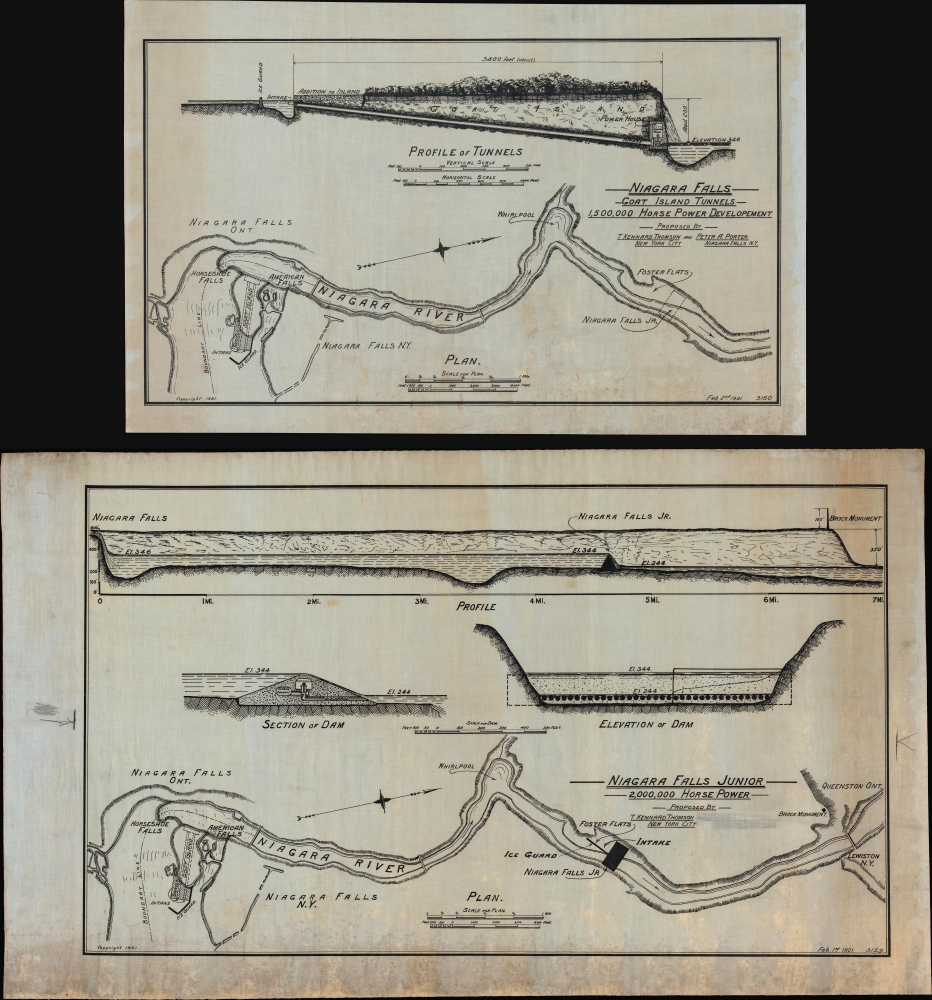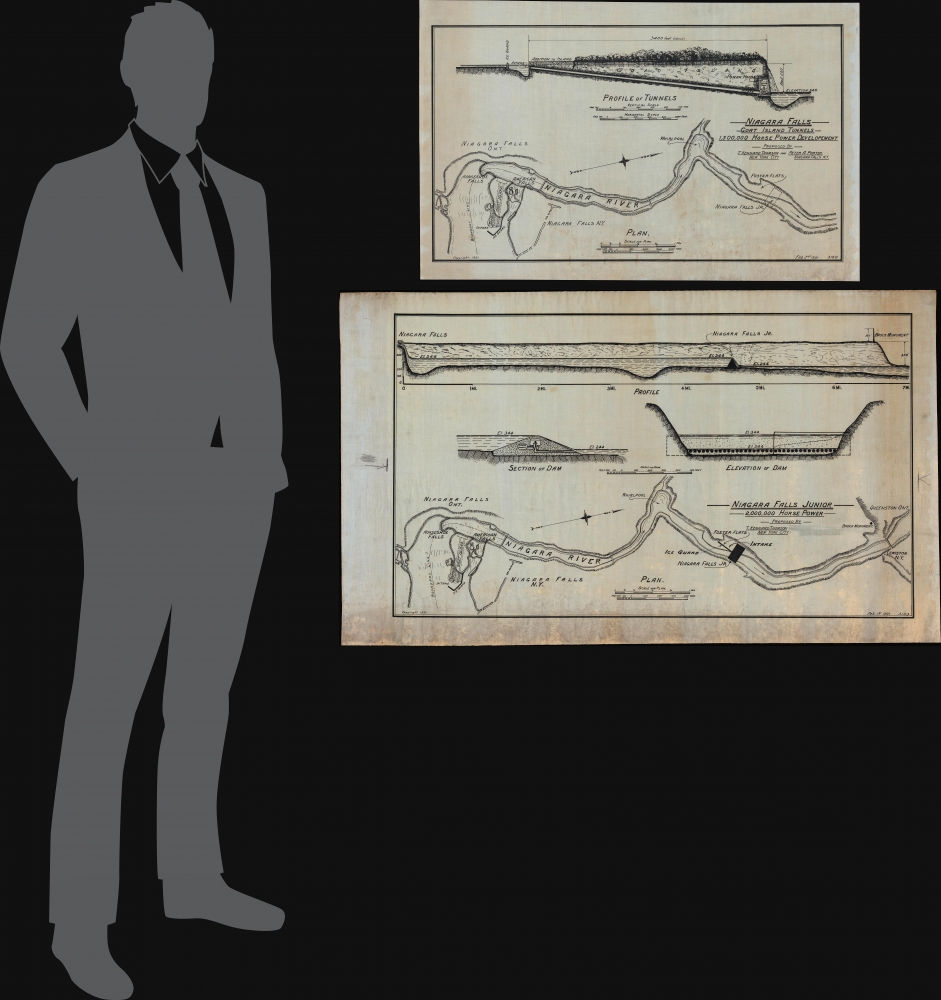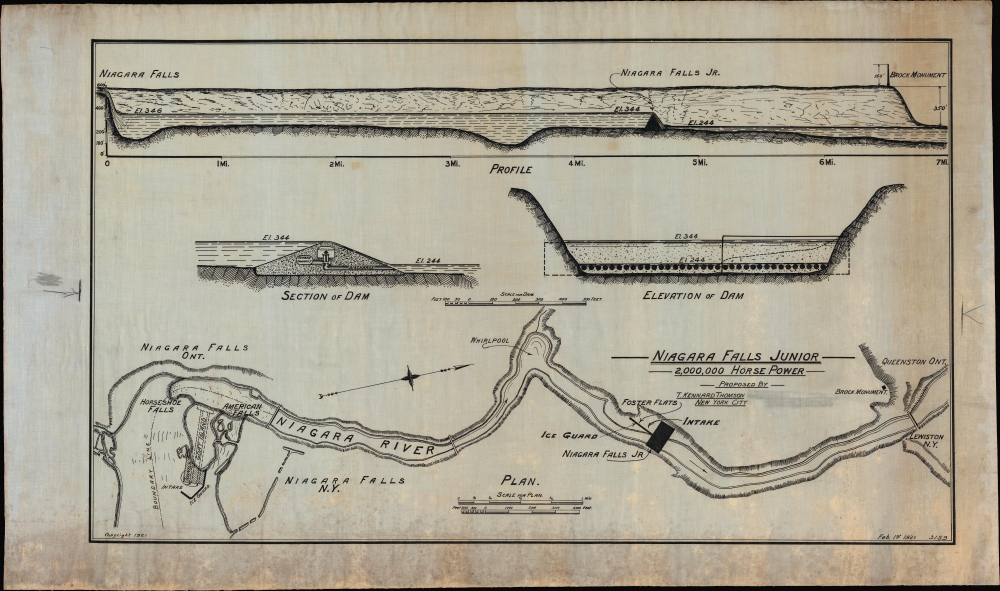1921 T. Kennard Thomson Schematic of Proposed Dam, 'Niagara Falls Junior'
NiagaraFallsJr-kennardthomson-1921
Title
1921 (dated) 21.75 x 40.5 in (55.245 x 102.87 cm) 1 : 12000
Description
A Closer Look
This is a set of two hand-drawn maps illustrating maps and transverse views of the proposed dam, to be located near Foster (or Fosters) Flats, just downriver from a whirlpool on the Niagara River.The larger sheet features a profile view of the Niagara River and Niagara Gorge, from the Falls to Brock's Monument, displaying the elevation changes of the river. Two drawings at center demonstrate the changes in elevation at the dam site from the side and head-on (looking upriver). At bottom is an overhead plan, oriented towards the west-northwest, covering an area from the Falls to Lewiston, indicating the proposed location of the dam.
A second, smaller sheet focusing on proposed tunnels under Goat Island is divided roughly in half, with the top portion demonstrating the plan for building intake tunnels underneath Goat Island, which Porter's ancestors had owned before selling it to the Niagara Reservation (the first state park in the U.S.) in 1885. These tunnels could be used to generate power from water that would otherwise be 'wasted' by flowing over the Falls (though it was assumed that the diminished flow would somewhat reduce the majestic power of the Falls). At bottom is the same overhead plan also present on Kennard Thomson's main dam proposal schematic. At various points, the tunnels under Goat Island were proposed as either a supplement to the dam (as here) or as a standalone project. In either case, they were, from a technical perspective, by far the easier of the two projects to accomplish, though they, like the dam, were never completed.
Niagara Falls Jr.
The notion of constructing a hydroelectric dam across the Niagara River was most stridently advocated by two men, Kennard Thomson, who drew this schematic, and Peter A. Porter, a local politician who served in the New York State Assembly and U.S. House, and who had headed the Niagara River Hydraulic Tunnel, Power, and Sewer Company earlier in his career. The dam planned out by Thomson and Porter, along with other modifications such as new tunnels under Goat Island, promised to deliver 2,000,000 horsepower, which would significantly increase the power available throughout New York, even accounting for the power generation that would be devoted to the Canadian side of the falls. Through the Thomson-Porter Cataract Co. (seemingly short-lived) and the Lower Niagara River Power and Water Supply Company, in conjunction with other proponents of the project, Thomson and Porter were able to gain approval permits from the state of New York. The plan garnered significant public interest in support, including a front-page feature in the Scientific American on April 2, 1921.However, significant progress was never made on building the dam, perhaps because Porter died in 1925, while Thomson appears to have been drawn to other projects, including skyscrapers and bridges in New York City (it also seems that the Canadian government never approved the project). In any event, existing sites (such as the Schoellkopf Power Station) were expanded in the following years, an easier means of increasing the power supplied by the Falls than the highly ambitious Thomson-Porter proposal.
Incidentally, after the partial collapse of the Schoellkopf Power Station in 1956, a new structure was built by the New York Power Authority on the same site. It was later named after Robert Moses (1888 - 1981), who headed the agency. Moses traveled in the same social circles as Kennard Thomson and the two New Yorkers shared a penchant for ambitious urban infrastructure.
Publication History and Census
This schematic was drawn on surveyor's linen by Thomas Kennard Thomson in 1921. These are the manuscript revisions of plans first presented in his and Porter's c. 1915 work Niagara Falls Junior and a 2,000,000 Horse Power Development (cataloged among the holdings of the University of Chicago, the University of Buffalo, and Wisconsin Historical Society in the OCLC; the University of Chicago independently catalogs a smaller-format printing of the Goat Island Tunnels sheet). Jointly owned with Boston Rare Maps.Cartographer
Thomas Kennard Thomson (April 25, 1864 - July 1, 1952) was a New York City based civil engineer active in the first half of the 20th century. Thomson was born in Buffalo, New York, the son of William Alexander Thomson (1816 - 1878), founder and builder of the Canada Southern Railroad. He studied at the University of Toronto, graduating in 1886, then returning for a degree in Civil Engineering and a Doctorate of Science. He initially worked in Canada, first on the Canadian Pacific Railroad in the Rocky Mountains, then with the Dominion Bridge Company in Montreal. He moved to Brooklyn, New York, in 1889, initially taking a position with Pencoyd Bridge Company of Pennsylvania. He left this position within a year to attend the Paris Exhibition with the American Society of Civil Engineers. Thomson returned to a long and successful engineering career, working on hundreds of major projects, including more than 50 skyscrapers and 200 bridges. His New York City projects included the Singer Building (149 Broadway), the Commercial Cable Building (22-24 Broad Street Extension, demolished 1954), the Government Assay Building (40 Wall Street), the Mutual Life Building, and the Manhattan Municipal Building (1 Centre St). He was also one of five consulting engineers in charge of the New York Barge Canal (1814 - 1915) and developed a plan to build a dam in the whirlpool Rapids of the Niagara Falls. For a time, he served as chief engineer for Arthur Mullin, the foundation contractors behind some of Manhattan's early skyscrapers. He worked as a consulting engineer for the city until a week before his death of stroke, at age 88. Although his contributions to American engineering are innumerable, Thomson is best remembered today for proposing a massive extension of Manhattan into New York Harbor - although it never happened, the proposal received national media attention and is remarkably persistent, having been reproposed as recently as 2022. More by this mapmaker...






